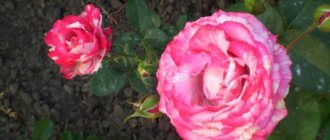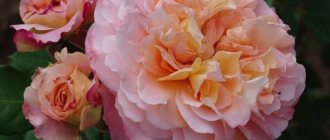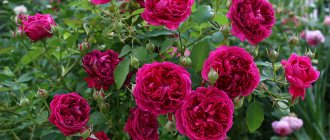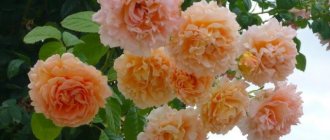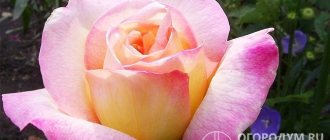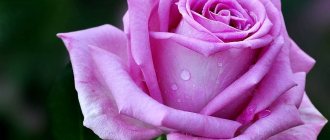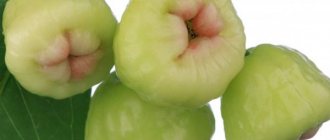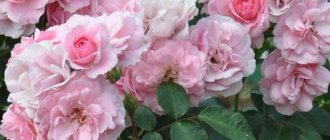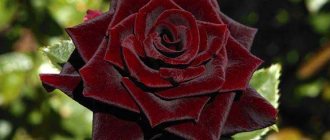History of selection
Rose "Golden Celebration" was created at the end of the 20th century in the famous company of D. Austin. The basis for the new variety was two already known species:
- Charles Austin.
- Abraham Darby.
The result is a species with delicate yellow-orange flowers and the best characteristics of floribundas, climbing roses and tea roses. The author timed the name of the variety to coincide with the anniversary of the British Queen.
Rose "Golden Celebration" belongs to the group of scrubs
Later, the Golden Celebration rose participated in many exhibitions and competitions and repeatedly received prizes and diplomas.
Description and characteristics of the English park rose variety Golden Celebration
The rose is a bush rose, but its shoots are very long, and with good care and favorable conditions they reach 4 m. The stems are plastic, covered with thorns and hard emerald leaves of a dense structure, glossy on the outside.
The main value of the Golden Celebration rose is its flowers. Blooming buds of unusual color. It is compared to the rich color of egg yolk, where pink and peach tones are present. This combination gives the effect of a golden-copper hue. Flowers up to 14 cm in diameter are collected in huge inflorescences of 6-7 pieces. They droop under their own weight, but look decorative. The petals are very graceful - the wavy edge of the outer ones is turned outward, the inner ones create a dense core.
Rose "Golden Celebration" blooms several times per season. The largest number of buds appears on it during the first wave, in early June. The end of flowering occurs in October, after the onset of the first frost.
The fruity aroma of Golden Celebration rose is subtle and very pleasant.
The variety is unpretentious - it can grow on soil poor in organic matter and in short daylight hours (4-5 hours). The plant is immune to major diseases. Despite its high frost resistance (up to -20 ⁰С), it requires reliable shelter for the winter.
Rose Golden Celebration: general description
The Golden Celebration rose was bred by the David Austin breeding firm in 1992. Having earned the prestigious Award of Garden Merit, which is awarded annually by the British Royal Horticultural Society, this variety is today rightfully considered one of the best creations of the nursery.
A general idea of the Golden Celebration rose can be obtained from the parameters table:
| Evaluation parameter | Characteristic |
| Color | Golden yellow |
| Number of flowers per stem | 3-5 |
| Aroma | ❀❀❀ |
| Flower size | 14-16 cm |
| Height | 150 cm |
| Width | 100-120 cm |
| Growing area (USDA) | Zone VI (Lower Volga region, Voronezh, Kaliningrad regions, Rostov-on-Don) |
| Winter hardiness | ❄ |
| Powdery mildew resistance | ★★★ |
| Black spot resistance | ★★★ |
| Rain resistance | ☂ |
| Flowering period | ☀☀ (re-blooming) |
| Boarding time | April or end of October |
On the official website of the David Austin nursery, the Golden Celebration variety is presented in standard form, which proves the high plasticity of this rose.
The undeniable advantage of the variety is its giant peony-shaped flower. Its antique cup-shaped shape successfully harmonizes with the yellow color of the petals, unusual for antique roses, and the racemose arrangement of the flowers makes the bush an object of general attention in any flower garden.
Additional benefits of Golden Celebration rose:
- high resistance to fungal infections;
- remontant flowering;
- ability to grow rapidly.
The main disadvantage of this variety is the flower’s instability to rain. Also, the Golden Celebration rose requires increased attention in winter, since its winter hardiness is low.
Tip #1. The shade of Golden Celebration rose varies slightly depending on the degree of insolation. In partial shade, the flowers take on an almost copper tint, and in bright sun they can fade to pale yellow.
Advantages and disadvantages of Austin Golden Celebration rose
Thanks to enormous breeding work, the Golden Celebration variety has a number of advantages:
- ease of care;
- high decorativeness of flowers;
- their unusual color;
- greater vigor of shoot growth;
- repeated flowering per season;
- resistance to major fungal diseases;
- average number of thorns on stems.
Water the plant carefully, in a thin stream, and only at the root.
The list of disadvantages of the Golden Celebration variety is very short:
- decreased decorativeness of inflorescences after prolonged rains;
- burning of petals under the bright sun;
- the need for serious shelter in regions with cold winters.
Recipe for rose petal jam
So, a story from the Prima Donna - on the 10th anniversary of their marriage, Philip K. gave her a rose for every day they lived together. This is a sea of flowers A.B. decided to turn it into jam, which she still treats her guests to (information from the program “Property of the Republic. Alla Pugacheva”).
History is silent about the type of roses given, but the jam made from Golden Celebration petals will be remembered for a long time. Delicious and very aromatic, with a mango aftertaste, especially if you add lemon instead of citric acid. Its taste is not inferior to its beauty: transparent golden petals in golden syrup...
For this jam you need:
- 2 cups petals;
- 2 cups granulated sugar;
- 1 glass of water;
- 3 tablespoons lemon juice.
Reproduction methods
The Golden Celebration variety is propagated using cuttings. Planting material is obtained from bushes that have already grown and become stronger. Cuttings are cut after the first wave of flowering. This time falls from mid-June to the third decade of July. Select a stem of medium thickness and cut it into pieces about 20 cm long. The lower cut is made oblique, at an angle of 45⁰, the upper cut is made straight (90⁰). To reduce evaporation, the leaves on the cuttings are shortened by half.
In spring, the cover from the rose is gradually removed so that it adapts to the sun.
In order for the planting material to take root, it is dipped in a solution of one of the stimulants (Kornevin, Heteroauxin, Zircon) or the cut is dusted with its powder form. Consistent use of both soaking and powdering is acceptable.
In special mini-greenhouses, the soil is prepared so that there is ordinary garden soil at the bottom, and a 5 cm layer of sand on top. The soil is well watered and the cuttings are planted in it up to the first leaf. Moderate humidity is maintained for 3 weeks, after which old leaves may dry out and fall off, but new ones will appear. This will mean that rooting has occurred. After a month and a half, the cutting already looks like a small bush.
Important! Emerging buds must be removed to speed up the growing season.
For the winter, young Golden Celebration roses are left in the same place, reliably protected from winter frosts. In spring, the seedlings are transplanted to the place chosen for them in the garden.
Features of bush care
The park rose Golden Celebration can be quite capricious during the growing process, so it requires sensitive care: constant fertilization, loosening the soil, regular watering and timely removal of all weeds.
It should be watered twice a week, and if the weather is dry, more so that the bush does not dry out. When watering, you need to ensure that water regularly reaches the root system. Water should be given according to the following calculation: seven liters is enough for a young bush, but an older plant will need up to fifteen liters per watering.
As a top dressing, it is recommended to use fertilizers containing nitrogen, which will stimulate the growth of bushes, which is especially important for young seedlings. When the first buds appear, fertilizers containing potassium and phosphorus will be required.
Before the flowering stage, you should not give the plant nitrogen, because it is beneficial for the density of the foliage and can slow down the growth of buds.
Seasonal pruning is very important. It is held three times: in the spring, summer and autumn seasons.
In the spring, pruning will help awaken the rose and stimulate it after a vegetative state in winter, and a similar procedure in summer will provide a large number of beautiful flowers. In the fall, the rose also needs to be pruned: in this case, such an event will serve to prepare the bush for wintering.
Question 1: is it possible to take cuttings from a Golden Celebration rose?
The variety will reproduce well by cuttings, but it is important to remember that the soil should be close to ideal: with a lot of humus, well loosened, without an abundance of sand. There should also be no increased acidity: it should be neutralized by adding ash
When using this propagation method, it is important to take into account the level of groundwater, the depth of which must be at least two meters.
Question 2: in what months do the waves of flowering occur for the Golden Celebration rose?
The intensity of flowering is directly related to the climate in a particular region. All English roses are distinguished by the fact that they begin to bloom early, and even in our harsh latitudes they bloom as early as June. A short break follows, and the rose may bloom a second time - as a rule, this happens at the end of August or at the beginning of September. If we are talking about regions with a favorable and warm climate, the bush can please its owners with continuous flowering.
This variety of English rose with a beautiful and memorable name will decorate any garden. Do not be afraid of some difficulties in care. If you follow a few rules and follow the recommendations of experienced gardeners, the flower will definitely thank the owner with its unique beauty.
Bush rose Golden Celebration, brief overview, description of characteristics, where to buy seedlings:
Growing and care
Despite its royal appearance, the Golden Celebration rose is undemanding to growing conditions; caring for it is not difficult even for novice gardeners. After choosing a location and planting, caring for the plant consists of regular irrigation, fertilization, pruning and preparation for winter.
Selecting a location
For planting, you need a place protected from northern winds and drafts. A 5-hour daylight period is sufficient for the plant. The sun can illuminate the rose in the morning and evening hours; in the midday heat it should be covered by a light shadow.
The soil
The best soil for Golden Celebration roses is breathable loam with an alkaline reaction without high groundwater. Before planting, they dig it up, removing weed roots, and add wood ash and organic matter.
After rain, rose petals get wet and quickly fall off
Watering
The main requirement for watering Golden Celebration roses is regularity and moderation. An adult plant needs 7-10 liters of water once every 3 days. In intense summer heat, water more often.
Important! When irrigating the bushes, do not allow drops to fall on the foliage to avoid burns.
Top dressing
They begin to apply fertilizer to the Golden Celebration rose from the second year according to the following scheme:
- nitrogen fertilizing - in early spring, during the beginning of the growing season;
- phosphorus and potassium - during budding;
- superphosphate and potassium salt - after flowering.
Important! Rose "Golden Celebration" does not tolerate feeding in the form of fresh manure.
"Golden Celebration" has average resistance to frost, so it needs to be covered
Trimming
This procedure is carried out several times. In spring, damaged and diseased shoots are removed. After flowering, thin out the bush, cutting out branches growing inward. In autumn, the rose is prepared for winter by shortening the stems to 3-4 buds.
Features of growing Golden Celebration roses in Siberia
The variety "Golden Celebration" is one of the five roses most adapted to the conditions of Siberia. In order for the bush not to freeze out, but to quickly develop and bloom, it is necessary to fulfill the planting conditions:
- Plant in the shade of sparsely leafed shrubs on the south side of the site.
- Select high places for planting, where the soil freezes less and the roots wake up early.
- Plant in a permanent place in May, after the soil has warmed to +10 ⁰C.
- The optimal composition of the soil mixture should include peat, clay, ash, humus and sand.
- Place the grafting site 8 cm below the soil surface.
- Hill up the bush high.
It is very important to provide the Golden Celebration rose with reliable shelter in the harsh Siberian winters. It must be dry to prevent freezing and rotting of the seedling. Alternatively, you can use a structure consisting of an arc frame, spruce spruce branches, non-woven material and polyethylene film. Under cover, the bush is covered with dry soil and leaves.
Important! Before frost sets in, a “window” should be left in the shelter for ventilation.
In Siberian conditions, experts advise watering the roots with an epin solution at the onset of spring in order to revive them as quickly as possible after a harsh winter.
Climbing or climbing roses
Climbing or creeping roses have thin, long flexible shoots and lush caps of inflorescences and bouquets. They most often bloom once on last year's shoots , which flower growers try to preserve for this reason. Only weak shoots and old faded long branches are cut out entirely. Side shoots are shortened by 2-3 eyes. These roses can grow wildly, forming thickets, like in the fairy tale about the sleeping beauty. Such bushes are rejuvenated every 7-10 years, pruned at a level of 50-70 cm from the ground.
In remontant varieties of climbing roses, fading flowers must be regularly removed. Trim the emerging young side shoots to 2-5 buds. Periodically remove 4-year old branches, cutting them off at the ground by 3-5 buds. When growing climbing roses on a trellis, you need to remember: if positioned strictly vertically, they will bloom less along the entire length of the shoot. But if you place them horizontally or bend them in an arc , they will grow lateral branches and bloom wildly. If the rose is grown on an obelisk, and it is impossible to position the shoot horizontally, then it can be wrapped around the support in a spiral.
Climbing rose “Pierre de Ronsard”
Pests and diseases
Rose "Golden Celebration" has high immunity and rarely suffers from fungal diseases. Under unfavorable weather conditions, black spot may occur, which must be controlled with fungicides.
The pests that most often attack the Golden Celebration rose include aphids and spider mites. If the number of insects is small, they are collected manually. In case of massive damage to the bush, insecticides are used.
Important! When harmful insects appear on plants adjacent to roses, preventive spraying is carried out.
Rose blossom
Rose Celebration blooms for a long time, and flowering can occur several times in one season. The first wave of flowering is characterized by its abundance. Golden begins to bloom buds in early June, and this process continues until mid-October with a short break towards the end of summer. It is during this period, around August or September, that the second wave of flowering begins. It is not as abundant and long as the first one, but no less beautiful.
Care during and after flowering
During flowering, the number of fertilizing is reduced; it is recommended to apply fertilizer only once. It is better to use special complex preparations with a high content of potassium and phosphorus. Nitrogen can harm the bush during flowering, so it is highly not recommended to fertilize Golden with it.
Application in landscape design
Thanks to its decorative properties and long-lasting flowering, the Golden Celebration rose is widely used by designers to decorate plots, parks and public gardens. It looks great as a hedge, on alpine hills, flower beds and rock gardens. The plant is easy to grow in open ground, on the balcony, in greenhouses and greenhouses.
Single plantings of roses against the backdrop of green conifers are especially impressive. Solitaires made of golden flowers against the background of an emerald lawn amaze with the splendor of the created picture.
The ability to grow the Golden Celebration rose as a climbing rose provides new, additional design options. You can decorate a wall, arch, fence, or central entrance with it, giving the area comfort and uniqueness.
The rose can be used for cutting, creating bouquets, compositions, wreaths, planting in containers and flowerpots.
Important! Roses planted in flowerpots or pots need to be pruned on time.
Agricultural technology
This plant does not tolerate shade well, and its flowers quickly fade under the hot midday rays of the sun, so the best site for them is where the sun illuminates the bushes in the morning and evening hours, and during the day the rose falls into light partial shade from a building, hedge or fruit trees.
The place for planting bushes should be protected from gusts of cold wind and strong drafts. The area for planting is prepared in advance, preferably in the fall: manure or other organic matter (compost or humus) must be added for digging. In the spring, the site is dug up again and complex mineral fertilizers are applied.
Important! The soil should not be too acidic, so before planting you can add 1 tbsp. wood ash
Seedlings can be planted in open ground in spring or autumn. It is better for novice gardeners to plant this rose in the spring so that it takes root well and gets stronger over the summer, but in the fall such a gardener may not guess the planting time, the plant will not acclimatize in the new place and will freeze in the winter.
Planting material should be planted in the second ten days of May. The depth of the planting holes should be at least 0.4 m, since the roots grow very quickly and go deep into the soil. The root collar is buried 2.5-3 cm into the soil. If it is deepened too much, the bush will degenerate into a rose hip and may not bloom at all.
After planting, the soil should be well compacted so that the seedling does not wobble, otherwise the bush will not be able to take root well.
This flowering shrub requires good care; if the gardener does everything wrong, he may not see abundant flowering.
The main requirements for caring for this variety:
- compliance with the irrigation regime;
- loosening the soil while simultaneously removing weeds;
- mulching the tree trunk circle after watering;
- regular application of fertilizers throughout the season;
- pruning shrubs in spring and after flowering (if necessary).
The following watering regime should be observed:
- bushes are irrigated once every 3-4 days;
- in hot weather, the amount of watering is increased;
- in the rainy season they moisten less often.
Note! The rate of single watering for young bushes is 7-8 liters, for adult plants - 2 times more. After each watering, the soil should be loosened, all weeds removed and a layer of mulch added - humus, sawdust or grass
After each watering, the soil should be loosened, all weeds removed and a layer of mulch added - humus, sawdust or grass.
These flowering bushes should be fed several times a season. In the spring, mineral fertilizers containing nitrogen are applied to the plants, since this microelement promotes the active growth of vegetative mass. As soon as the first buds appear on the shoots, you should fertilize again. During this period, fertilizers that contain phosphorus and potassium will work well, and nitrogen fertilizing is excluded, otherwise stems and foliage will actively grow on the bushes to the detriment of abundant flowering.
During the flowering period, potassium-phosphorus fertilizers are applied again, and at the end of the flowering period, before the onset of cold weather, the rose bushes are fed for the last time, adding superphosphate and potassium salt.
In the spring, before the appearance of young foliage, sanitary pruning is carried out. It is necessary to remove all damaged, diseased, frozen and dried shoots. This procedure activates the growth of the bush. In summer, excess young shoots growing inside the bush should be removed to avoid thickening, as well as fading buds. Autumn pruning is carried out as necessary.
